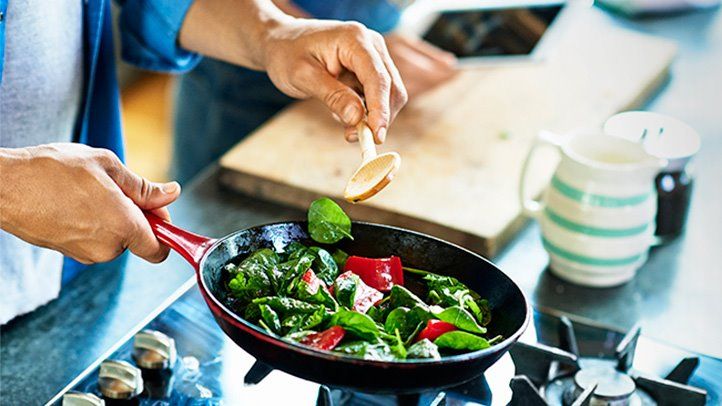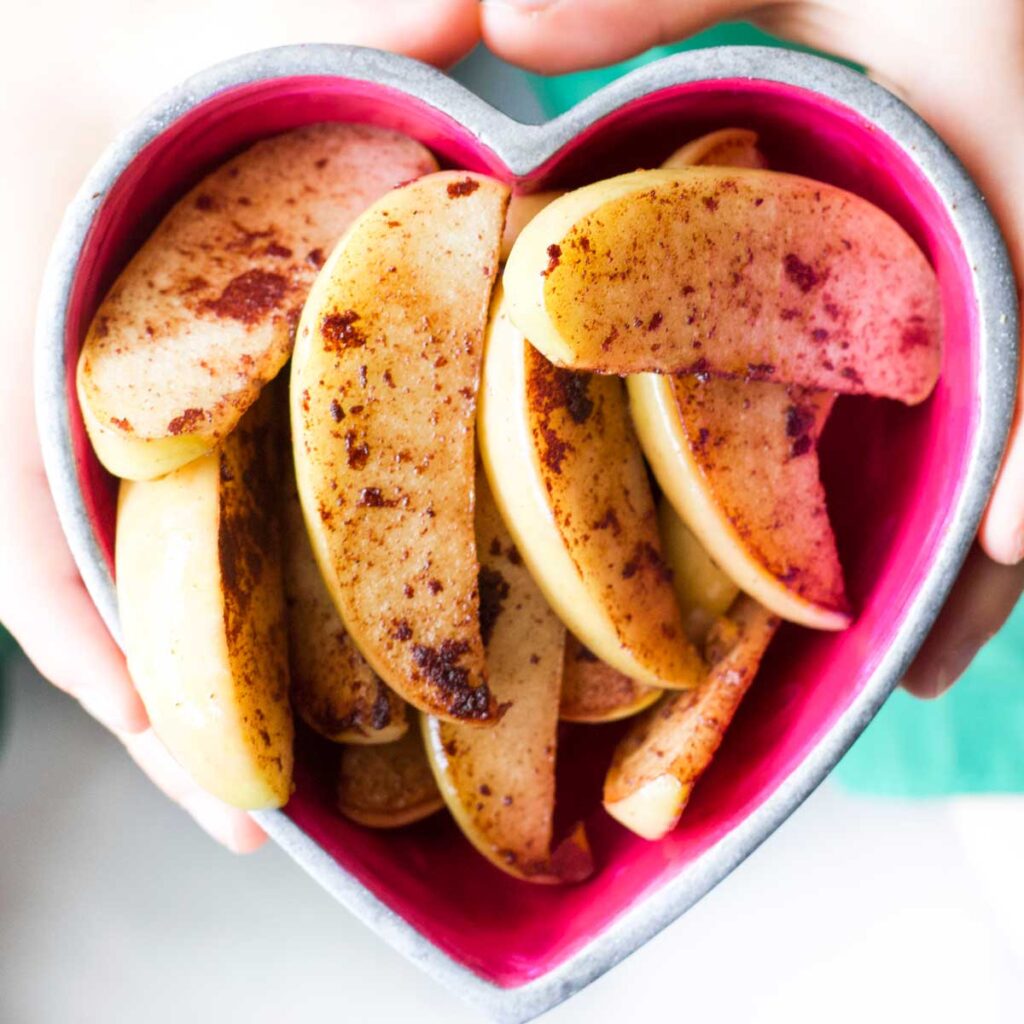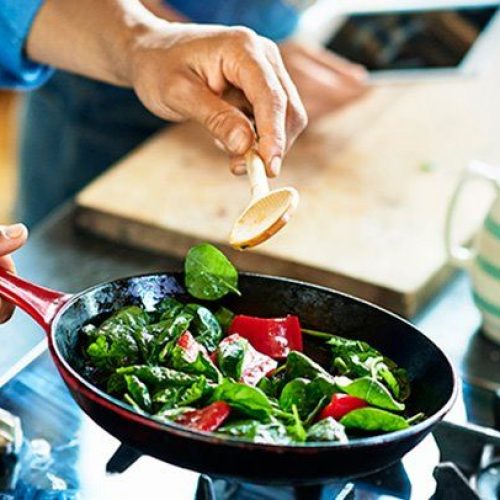To make apple baby food, wash, peel, and dice apples, then steam or boil until tender, and finally blend into a smooth puree. Making homemade apple baby food is a simple and nutritious way to introduce your little one to solid foods.
Apples are a great choice because they are packed with vitamins and minerals like Vitamin C and potassium. Plus, they have a sweet taste that babies often enjoy. In this guide, we’ll walk you through the steps to make apple baby food from scratch.
By following these easy instructions, you can ensure that your baby gets the freshest and healthiest food possible. So grab a few apples and get ready to whip up a batch of delicious homemade apple baby food for your little one.
The Best Apple Varieties For Homemade Baby Food
The Best Apple Varieties for Homemade Baby Food
Introducing your little one to solid foods is an exciting milestone, and making your own baby food can be both convenient and cost-effective. Apples are an excellent choice for baby food because they are easy to prepare, nutritious, and appealing to most babies. However, not all apple varieties are suitable for homemade baby food. In this article, we will explore the best apple varieties to use when preparing homemade apple baby food.
Sweet and Mild-tasting Apples
When choosing apples for your baby’s food, opt for varieties that are sweet and mild in taste. These types of apples, such as Gala, Fuji, and Golden Delicious, are less tart and have a more appealing flavor for little ones. Their natural sweetness makes them a great choice for introducing new flavors to your baby. Plus, their mild taste is less likely to cause any digestive issues or allergies.
Organic Apples for Baby Food
Consider using organic apples for your homemade baby food. Organic apples are grown without the use of synthetic pesticides and are less likely to carry harmful residues. By choosing organic, you can reduce your baby’s exposure to pesticides and provide them with a purer and healthier food option. Look for the “Certified Organic” label on the apples to ensure their authenticity.
Avoiding Apples with Pesticide Residue
Pesticide residues can be harmful to your baby’s health, so it’s important to avoid apples that may contain high levels of residues. Conventionally grown apples are often treated with pesticides, so it’s best to purchase organic apples whenever possible. However, if organic options are not readily available or outside your budget, you can refer to the Environmental Working Group’s (EWG) annual “Dirty Dozen” list. This list highlights the fruits and vegetables with the highest levels of pesticide residues, allowing you to make informed choices for your baby’s food.
In Conclusion
When it comes to making homemade apple baby food, selecting the right apple variety is essential. Opt for sweet and mild-tasting apples such as Gala, Fuji, or Golden Delicious. Consider using organic apples to minimize pesticide exposure, and refer to the EWG’s list to avoid apples with high pesticide residues. By choosing the best apple varieties, you can ensure your baby enjoys a tasty and healthy introduction to solid foods.
Washing And Peeling Apples
When it comes to preparing apple baby food, it is crucial to start with clean and well-peeled apples. Properly washing and peeling the apples ensures that you remove any potential dirt, pesticides, or impurities that could be harmful to your little one. Additionally, it helps in achieving a smooth texture for your homemade apple baby food.
Thoroughly Cleaning Apples
To start, thoroughly clean the apples using clean water. This will help remove any residual dirt or residue on the surface. You can simply hold the apples under running water and gently rub them with your hands. Ensure that you cover all sides of the apple to get rid of any impurities.
| Step | Action |
|---|---|
| 1 | Hold the apple under running water. |
| 2 | Rub the apple gently with your hands to remove any dirt or residue. |
| 3 | Continue rinsing the apple until it feels clean. |
Removing the Skin for Smooth Texture
Next, it’s time to remove the skin from the apples. The skin can sometimes be tough and fibrous, which may not be suitable for your baby’s delicate palate. By removing the skin, you can achieve a smoother texture, making it easier for your little one to enjoy their apple baby food.
- Start by placing the washed apple on a clean cutting board.
- Using a sharp knife, carefully make a shallow incision around the top of the apple, just below the stem.
- Continue cutting in a circular motion until you have completed a full loop around the apple.
- Gently remove the top part of the apple.
- Repeat the same process at the bottom of the apple, creating another incision and removing the bottom part.
- Now, starting from the top, carefully peel the skin off in a downward motion.
- Continue peeling until all the skin has been removed.
- Once the skin is removed, you can proceed with cutting the apple into small pieces for cooking or pureeing.
By following these simple steps for washing and peeling apples, you are well on your way to creating nutritious and delicious apple baby food. Always remember to prioritize cleanliness and smooth texture for the best results.
Cooking Apples For Baby Food
When it comes to making homemade baby food, cooking apples can be a game-changer. Not only are apples a tasty and nutritious choice for your little one, but they are also incredibly versatile when it comes to preparation. By cooking apples, you can soften them to a perfect consistency that is easy for your baby to handle and digest. In this article, we will explore three simple methods for cooking apples for baby food: steaming, boiling, and baking.
Steaming Apples for Maximum Nutrient Retention
If you’re looking to preserve the maximum amount of nutrients in your baby’s apple food, steaming is an excellent option. Steaming apples helps retain their natural flavors and vital nutrients, ensuring that your little one gets the most out of each bite. To steam apples, follow these simple steps:
- Wash and peel the apples.
- Cut the apples into small, uniform pieces.
- Place the apple pieces in a steamer basket.
- Steam the apples over boiling water for about 10-15 minutes or until tender.
- Remove the apples from the steamer basket and let them cool before pureeing or mashing.
Boiling Apples for Quick and Easy Preparation
Boiling apples is a quick and easy method for preparing baby food. This method is perfect for busy parents who want to whip up a nutritious meal in no time. Here’s how you can boil apples for your baby’s food:
- Wash and peel the apples.
- Cut the apples into small, uniform pieces.
- Place the apple pieces in a pot and cover them with water.
- Bring the water to a boil, then reduce the heat and simmer until the apples are soft and tender.
- Drain the water and let the apples cool before pureeing or mashing.
Baking Apples for Enhanced Flavor
If you want to add an extra touch of flavor to your baby’s apple food, baking is the way to go. Baking apples bring out their natural sweetness and create a soft and creamy texture that your little one will love. To bake apples for baby food, follow these steps:
- Wash and peel the apples.
- Cut the apples into small, uniform pieces.
- Place the apple pieces on a baking sheet and bake them in the oven at 350°F (175°C) for about 20-25 minutes or until tender.
- Let the baked apples cool before pureeing or mashing.
By cooking apples using different methods, you can introduce variety and new flavors to your baby’s food while ensuring that they receive the necessary nutrients for their growth and development. Remember to always consult your pediatrician before introducing new foods to your baby’s diet. Happy cooking!

Credit: mykidslickthebowl.com
Blending Steamed Apples
Blending steamed apples is a quick and easy way to make smooth and nutritious baby food. Once you have steamed the apples to a soft consistency, the next step is to blend them. This process helps to break down the fruit and create a smooth puree that is easy for little ones to digest.
Using a Blender to Achieve Smooth Consistency
When it comes to blending steamed apples, a high-quality blender can be your best friend. It allows you to create a smooth consistency in a matter of seconds. Here’s how you can do it:
- Start by transferring the steamed apples into the blender.
- Secure the lid tightly to avoid any spills or leaks.
- Turn on the blender and gradually increase the speed to high.
- Blend the apples until you achieve a smooth and even texture.
- Once you are satisfied with the consistency, turn off the blender and carefully remove the lid.
Adding Water for Desired Texture
To adjust the texture of the apple puree, you may need to add some water during the blending process. This step is especially important if your baby is just starting out with solid foods and needs a thinner consistency. Here’s how you can do it:
- After transferring the steamed apples to the blender, start by adding a small amount of water.
- Blend the mixture at a low speed and gradually increase it until you reach the desired consistency.
- Keep in mind that you can always add more water if needed, but it’s harder to thicken the puree.
- Blend the mixture well, ensuring the water is well incorporated.
In conclusion, blending steamed apples is a simple and effective way to make delicious baby food. By following these steps and using the right blender, you can achieve a smooth and creamy texture that your little one will love.
Applesauce For Baby Food
Applesauce is a versatile and delicious option for introducing solids to your little one. Not only is it easy to prepare, but it’s also packed with nutrients that are essential for your baby’s growth and development. In this article, we’ll explore two variations of applesauce that you can make for your baby: chunkier applesauce for older babies and sweetened applesauce with cinnamon or nutmeg.
Preparing Chunkier Applesauce for Older Babies
As your baby grows, their chewing skills develop, and they are ready for more textured foods. Chunkier applesauce is a great way to introduce them to more solid textures, helping them transition to mashed and eventually diced foods. Follow these steps to prepare chunkier applesauce:
- Start by selecting ripe and sweet apples. Organic varieties are preferable as they are less likely to contain pesticides.
- Wash the apples thoroughly and peel them. Removing the skin will ensure a smoother texture.
- Remove the core and seeds from the apples.
- Chop the apples into small chunks. The size of the chunks will depend on your baby’s ability to handle more solid foods.
- Place the apple chunks in a saucepan and add a small amount of water, just enough to cover the bottom of the pan.
- Cook the apples over medium heat until they become soft and tender, typically around 10-15 minutes.
- Remove the pan from the heat and let the apples cool for a few minutes.
- Mash the cooked apples with a fork or blend them in a food processor for a smoother consistency.
- Serve the chunkier applesauce as is or mix it with other pureed fruits or vegetables for added variety.
Sweetening Applesauce with Cinnamon or Nutmeg
If you’d like to add a touch of natural sweetness and flavor to your baby’s applesauce, try incorporating cinnamon or nutmeg. Not only do these spices enhance the taste, but they also have potential health benefits. Here’s how you can sweeten your baby’s applesauce:
- Prepare a batch of homemade plain applesauce using the steps mentioned earlier.
- Take a small amount of applesauce and transfer it to a bowl.
- Add a pinch of cinnamon or nutmeg to the applesauce and mix it well.
- Taste the sweetened applesauce to ensure the level of spiciness is appropriate for your baby’s palate.
- If needed, gradually add more spice and mix until you achieve the desired flavor.
- Store the sweetened applesauce in an airtight container in the refrigerator for future use.
Your baby will love the delightful taste of cinnamon or nutmeg-infused applesauce, making mealtime even more enjoyable!
Apple Puree Storage
Once you have made a batch of smooth and delicious apple puree for your little one, it’s important to know how to store it properly to maintain its freshness and nutritional value. Proper storage will ensure that you always have a supply of nutritious apple puree ready to serve to your baby whenever needed. Let’s explore two simple methods of storing apple puree: freezing it in ice cube trays and storing it in airtight containers.
Freezing Apple Puree in Ice Cube Trays
Freezing apple puree in ice cube trays is a convenient way to portion out small servings that can be easily defrosted as needed. Here’s how you can do it:
- Begin by spooning the apple puree into clean ice cube trays. Make sure to leave a small gap at the top of each compartment as the puree will expand during freezing.
- Smooth the surface of the apple puree in each compartment with a spoon to ensure even freezing and to remove any excess air bubbles.
- Place the ice cube trays in the freezer and let the apple puree freeze completely. This usually takes around 4-6 hours.
- Once the apple puree is frozen, remove the ice cube trays from the freezer and gently pop out the individual cubes.
- Transfer the frozen apple puree cubes to a ziplock bag or an airtight container for long-term storage.
- Label the bag or container with the date to keep track of its storage duration.
When you’re ready to serve the apple puree to your baby, simply defrost as many cubes as needed in the refrigerator overnight or by using a microwave on a low heat setting, ensuring the puree is not too hot before feeding your little one.
Storing Apple Puree in Airtight Containers
If you prefer not to freeze apple puree in individual portions, storing it in airtight containers is another great option. Follow these steps:
- After making the apple puree, allow it to cool to room temperature before storing it.
- Once cooled, spoon the puree into clean, sterilized airtight containers, leaving a small amount of headspace to allow for expansion during freezing.
- Seal the containers tightly to prevent any air or moisture from entering.
- Label the containers with the date and contents for easy identification.
- Place the containers in the freezer, ensuring they are on a level surface to avoid any spills or leaks.
When you’re ready to use the stored apple puree, simply transfer a portion to a clean bowl and allow it to defrost in the refrigerator overnight. Make sure to use the defrosted puree within 24-48 hours and discard any leftovers.
Both freezing apple puree in ice cube trays and storing it in airtight containers are effective methods for preserving the freshness and nutritional value of this homemade baby food. Choose the method that suits your needs best and enjoy the convenience of always having a supply of apple puree ready for your little one’s next meal!
When To Introduce Apples To Your Baby
Introducing solid foods to your baby is an exciting milestone. As a parent, it’s important to navigate this journey with your little one, ensuring they receive the right nutrition while considering their developmental readiness. When it comes to introducing apples, here are a few factors to consider:
Considering Food Allergies and Digestive Readiness
Before introducing any new food to your baby, it’s essential to be aware of potential food allergies or sensitivities. Apples are generally considered a low-allergy food, making them a great option for early introduction. However, it’s always a good idea to consult your pediatrician before starting any new foods, especially if your baby has a family history of allergies.
Furthermore, it’s important to ensure your baby’s digestive system is ready for solid foods. Most experts recommend introducing solids around 6 months of age, when babies can sit up with support and show signs of readiness, such as increased interest in food, ability to chew, and tongue movement coordination.
Determining Texture and Preparation
When introducing apples to your baby, the texture and preparation method play a crucial role in their acceptance. For younger babies who are just starting on solids, it’s best to begin with smooth purees. You can gently cook the apples until tender and then blend or mash them into a silky consistency. As your baby gets older and more comfortable with different textures, you can gradually introduce mashed or finely chopped apples.
Adding Apples to a Balanced Diet
While apples are a nutritious addition to your baby’s diet, it’s important to remember that they should be a part of a varied and balanced meal plan. Including a mix of fruits, vegetables, proteins, and grains will ensure your little one receives all the necessary nutrients for their growth and development. A diversity of flavors and textures will also help expand their palate and encourage healthy eating habits in the long run.
In conclusion, introducing apples to your baby can be a delicious and nutritious choice. By considering their readiness, and texture preferences, and ensuring a balanced diet, you can set them on a path to healthy eating and help them explore the wonderful world of food. Remember to consult your pediatrician for specific recommendations regarding your baby’s individual needs.
Serving Apple Puree To Babies
One of the best foods to introduce to your little one’s diet is apple puree. Apples are not only delicious and nutritious, but they are also easily digestible, making them an ideal choice for babies who are just starting solid foods. In this section, we will explore two important aspects of serving apple puree to babies: starting with small amounts and gradually increasing, and mixing apple puree with other fruits and vegetables.
Starting with Small Amounts and Gradually Increasing
When you introduce apple puree to your baby, it is important to start with small amounts and gradually increase the quantity. This allows your baby’s digestive system to adjust and prevents any potential digestive discomfort. Begin by offering just a few spoonfuls of apple puree during mealtime, and observe how your baby reacts. If they seem to enjoy it and have no adverse reactions, you can gradually increase the portion size over time.
Here are some tips to keep in mind:
- Start with organic and preferably locally sourced apples. This ensures that your baby gets the maximum nutrients without any harmful chemicals.
- Peel and core the apples before cooking them. You can steam, boil, or bake the apples until they are soft and easy to puree.
- Mash or puree the cooked apples using a blender or food processor until you achieve a smooth and lump-free consistency.
- Introduce a small amount of apple puree during mealtime, alongside your baby’s usual milk or formula feed.
- Observe your baby’s reaction to apple puree. If they show any signs of allergies or intolerance, such as rashes, vomiting, or diarrhea, consult your pediatrician immediately.
- As your baby gets comfortable with apple puree, gradually increase the portion size, offering it as a standalone meal or mixing it with other foods.
Mixing Apple Puree with Other Fruits and Vegetables
While apple puree is delicious and nutritious on its own, you can enhance its flavor and nutritional value by mixing it with other fruits and vegetables. This not only introduces your baby to a variety of flavors but also provides a broader range of essential vitamins and minerals.
Consider the following combinations:
| Ingredient | Benefits |
|---|---|
| Banana | Provides natural sweetness and adds creaminess to the puree |
| Pear | Helps to improve digestion and adds a mild flavor |
| Sweet Potato | Offers a boost of Vitamin A and adds a touch of earthy sweetness |
To mix apple puree with other fruits and vegetables, simply puree them separately and then combine the desired portions. Ensure that the consistency is suitable for your baby’s age and developmental stage.
Remember, introducing new foods to your baby’s diet should be done gradually and under the guidance of your pediatrician. Start with small amounts, monitor their reactions, and gradually increase the portion size. The key is to provide a well-balanced and varied diet that contributes to your baby’s growth and development.
Monitoring Baby’s Reactions To Apple Baby Food
Introducing solid foods to your baby’s diet is an exciting milestone. As you embark on this new journey, it’s important to keep a close eye on your little one’s reactions to different foods to ensure their health and safety. When it comes to apple baby food, monitoring your baby’s reactions is especially important due to the potential for allergies or food sensitivities. In this section, we’ll explore the potential signs to watch out for and the importance of consulting a pediatrician for any concerns.
Potential Signs of Allergies or Food Sensitivities
When introducing apple baby food, it’s crucial to be aware of potential signs of allergies or food sensitivities that your baby may exhibit. While apples are generally well-tolerated, a small percentage of babies may develop adverse reactions. Some common signs to watch out for include:
- Development of rash or redness on the skin
- Swelling of the lips, tongue, or face
- Hives or welts
- Excessive fussiness or irritability
- Diarrhea or vomiting
These signs may indicate an allergic reaction or food sensitivity specific to apples. If you notice any of these symptoms after feeding your baby apple baby food, it’s essential to discontinue its use and consult your pediatrician for further guidance.
Consulting a Pediatrician for Any Concerns
It’s always wise to consult your pediatrician if you have any concerns about your baby’s reactions to apple baby food. They can provide professional advice and guidance based on your baby’s individual health history. Your pediatrician will be able to assess the severity of any allergic reactions or food sensitivities and recommend appropriate measures to ensure your baby’s well-being. While it can be worrying to see your baby experiencing discomfort or exhibiting signs of an allergic reaction, remember that your pediatrician is there to support you and provide the necessary medical care.
Apple And Banana Puree
One of the simplest and most versatile baby food recipes is apple and banana puree. This combination is not only delicious but also packed with essential nutrients that are beneficial for your little one’s growth and development. In this section, we will explore how to combine apples and bananas to create a flavorful puree and adjust its texture according to your baby’s developmental stage.
Combining Apples and Bananas for Added Flavors
When it comes to making apple and banana puree, the key is to choose ripe and flavorful fruits. Opt for organic apples and bananas if possible to minimize exposure to pesticides. Start by peeling and coring two medium-sized apples, then chop them into small cubes. Similarly, peel and slice two ripe bananas.
Next, steam the apple cubes until they are soft and tender. Steaming not only helps to retain the nutrients but also makes the apples easier to puree. Once the apples are steamed, allow them to cool for a few minutes before transferring them to a blender or food processor.
Now, add the sliced bananas to the blender or food processor along with the steamed apples. Blend the fruits together until you achieve a smooth and creamy consistency. If needed, you can add a small amount of water or breast milk to adjust the texture and make it easier for your baby to consume.
Adjusting the Texture for Baby’s Developmental Stage
As your baby grows, it is essential to adjust the texture of their food to match their developmental stage. At around 6 months old, your little one might be ready for their first taste of solid food. During this stage, aim for a smooth puree consistency similar to a thick soup.
However, as your baby progresses to 8-10 months, you can start introducing thicker textures to help them develop their chewing skills. Gradually decrease the amount of water or breast milk added to the puree, creating a thicker and chunkier consistency. You can also mash the fruits with a fork instead of blending them for added texture.
By 10-12 months, your baby may be ready for small soft pieces of fruit instead of purees. At this stage, you can offer diced or mashed apples and bananas to encourage self-feeding and enhance their sensory experience. Ensure the fruit pieces are small enough for your baby to pick up and easily chew.
In conclusion, apple and banana puree is a simple and nutritious choice for your baby’s first foods. By combining these fruits, you can create a delicious and versatile puree that can be easily adjusted to your baby’s changing developmental needs. Remember to choose ripe and organic fruits, steam them for optimum nutrients, and gradually modify the texture as your baby grows. Your little one is sure to love this tasty and healthy treat!
Apple And Sweet Potato Mash
Making your own baby food is not only cost-effective but also allows you to have control over the ingredients you feed your little one. One fantastic combination that your baby will surely love is apple and sweet potato mash. This sweet and savory blend is not only packed with essential nutrients but also provides a delightful taste that will make mealtime a joy for your little one.
Creating a Savory Blend with Sweet Potatoes
When it comes to introducing new flavors to your baby, sweet potatoes are an excellent choice. Packed with vitamins A and C and fiber, they provide essential nutrients that support your baby’s growth and development. Combining the natural sweetness of apples with the nutty and earthy taste of sweet potatoes creates a delicious and nutritious mash that your baby will adore.
Roasting the Sweet Potatoes for Extra Flavor
To enhance the flavor of your apple and sweet potato mash, roasting the sweet potatoes is the way to go. Roasting brings out the natural sweetness and caramelizes the edges, providing a depth of flavor that will have your baby eagerly diving into their meal. It’s simple to do – just peel and chop the sweet potatoes, toss them in a little olive oil, and bake them in the oven until soft and golden. The roasted sweet potatoes will add a rich and savory element to the mash, making it even more irresistible to your little one.
Apple And Carrot Puree
One great way to introduce more vegetables into your baby’s diet is by preparing a delicious apple and carrot puree. Not only is this combination packed with nutrients, but it also offers a sweet and savory flavor that babies will love. In this section, we will guide you through the process of making apple and carrot puree, highlighting the benefits of steaming the carrots for optimal nutrient retention.
Introducing More Vegetables into Baby’s Diet
Introducing vegetables to your baby’s diet is an essential step in providing them with a well-rounded and nutritious meal plan. Vegetables like carrots are rich in beta-carotene, which is converted to vitamin A in the body, essential for healthy eyesight and a strong immune system. By combining carrots with apples, known for their high fiber and vitamin C content, you can create a perfect blend of flavors and nutritional goodness.
Steaming the Carrots for Optimal Nutrient Retention
When it comes to preparing the perfect apple and carrot puree, steaming the carrots is the way to go. Steaming helps retain the maximum amount of nutrients compared to boiling or roasting. By steaming the carrots, you ensure that essential vitamins and minerals are not lost during the cooking process. This method also helps the carrots retain their natural color and texture, making the puree more visually appealing to your little one.
Here’s a step-by-step guide on how to steam the carrots:
- Wash and peel the carrots.
- Set up a steamer basket in a pot with a small amount of water.
- Place the carrots in the steamer basket and cover the pot.
- Steam the carrots for about 10-15 minutes, or until they become tender when pierced with a fork.
- Remove the carrots from the steamer and let them cool.
Once the carrots are cooled, you can proceed with preparing the apple and carrot puree, following your preferred recipe. By steaming the carrots, you are ensuring that your baby gets the maximum nutritional benefits from this wholesome combination.
In conclusion, introducing more vegetables into your baby’s diet doesn’t have to be a daunting task. By preparing an apple and carrot puree, you can provide your little one with a healthy and delicious meal. Steaming the carrots enhances nutrient retention, ensuring that your baby reaps the full benefits of this nutritious combination.
Frequently Asked Questions Of How To Make Apple Baby Food
Can I Make Apple Baby Food At Home?
Yes, you can easily make apple baby food at home. Simply peel and chop the apples, then steam or boil them until they are soft. Mash or puree the cooked apples until you achieve the desired consistency for your baby.
Remember to cool the food before serving it to your little one.
At What Age Can My Baby Start Eating Apple Baby Food?
Babies typically can start eating apple baby food around 6 months of age. However, it is always recommended to consult with your pediatrician before introducing solid foods to your baby. They will be able to provide guidance based on your baby’s individual development and needs.
How Do I Store Homemade Apple Baby Food?
To store homemade apple baby food, transfer it to an airtight container and refrigerate it for up to 3 days. For longer storage, you can freeze the apple baby food in ice cube trays and then transfer the frozen cubes to a freezer-safe bag or container.
Thaw the cubes in the refrigerator before serving.
Can I Mix Apple Baby Food With Other Fruits?
Yes, you can mix apple baby food with other fruits to provide variety and introduce new flavors to your baby. Some great options to mix with apples include pears, bananas, peaches, and berries. However, it’s important to introduce new foods one at a time to monitor for any potential allergic reactions.
Conclusion
To sum up, making apple baby food is a simple and nutritious way to introduce fruits into your little one’s diet. By following these easy steps, you can provide your baby with a homemade, all-natural alternative to store-bought options. Remember to choose ripe apples, steam them for maximum nutrition, and puree them to the desired consistency.
Your baby will love the taste, and you can feel good knowing you’re nourishing them with wholesome food. Happy cooking!











